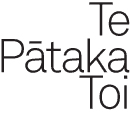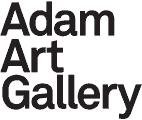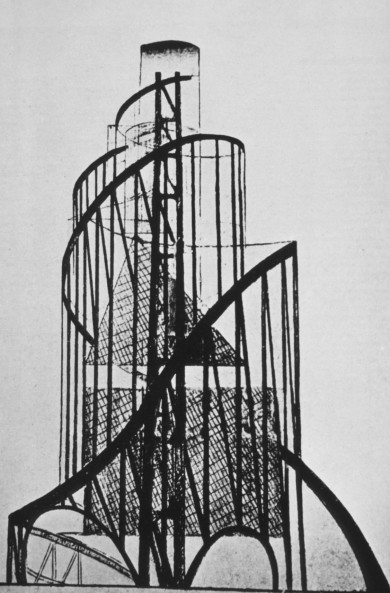Peter Trevelyan
As yet untitled 2009
20,000 0.5 millimetre pencil leads
Peter Trevelyan built a drawing in the most contained room of the Adam Art Gallery, where the walls and the floor accentuated the work’s form as a model for power – most effective when just visible. In considering the legacy of the university and the gallery set within this site. The Adam Art Gallery was originally designed around an exterior staircase, slotted between two buildings. Trevelyan’s work was presented in the Kirk Gallery, the only space that originally belonged to one of the gallery’s adjoining buildings; home to the study of science.
The installation-drawing is based on one of the rotating geometric structures of architect Vladimir Tatlin’s proposed Monument to the Third International. Never built, it was planned to be erected in St. Petersburg after the Bolshevik Revolution of 1917, and acted as the headquarters of and monument to Communist rule. Despite the fact that it was never completed, the form continues to resonate as a symbol of modernity and as a definitive expression of architectural constructivism embedded in a communist ideology.
Trevelyan has sampled just the central pyramid structure of Tatlin’s tower. This was envisioned as the hub of the organisation’s executive activities and, curiously, was designed to move, completing a rotation once a month. Trevelyan’s platonic shape also fragments and shape-shifts when viewed, forming multi-layered geometric angles which become difficult to grasp, let alone see. Quite remarkably Trevelyan’s pyramid was hand made out of 0.5mm pencil leads, the literal tool of drawing. As a drawing the work departs from a historical ideology, and as a structure it connotes the fragility of both political endeavours and the very act of construction.
[My] works investigate drawing itself. A drawing is a plan, a preliminary visualisation of something to be undertaken in the physical world. Drawing is an ancient technology, a system for postulating, organising and mapping information about the physical world and manipulating it in order to change or affect that world. While exploring the possibilities of different forms I received a very extensive education in the relative strengths and potentials of basic three-dimensional forms. Inadvertently I was experimenting with the series of forms known as the Platonic solids. Already I was intrigued by the possible readings of these three dimensional drawings as relating to the ideal forms postulated by Socrates in Plato’s Republic. Socrates uses “those who study geometry and calculation…” as an example to illustrate the properties of his ideal forms:
You know that they use visible squares and figures, and make their arguments about them, though they are not thinking about them, but of those things of which the visible are images … They make them into hypotheses as though they knew them, and will give no further account of them … Starting from these, they go on till they arrive by agreement at the original object of their inquiry [1].
Viewing the works in this way enabled me to clearly relate them to my research; they became models for complex systems, struggling to account for the mundane realities of occupying space. Constructed from pencil leads, a tool so closely linked to the development and advancement of technologies, the obvious fragility and sheer unlikelihood of these structures reflected the tenuous foundations I had discovered in all logic-based systems. Furthermore the structures created a confused subset of readings of the form itself, the multiplicity of lines mislead, distract and disorient the eye so that it can be difficult to discern the actual form, or even its dimensionality — Peter Trevelyan, 2008.
1. Plato, The Republic. trans. A. D. Lindsay. London: Everyman Library, 1906. 194.
Exploring the possibilities of unfamiliar artefacts and perceptual technologies as tools to draw with, Peter Trevelyan uses ‘drawing’ as a uniquely human way to plan, predict and affect our environment. Proposing that any new technology is an attempt to predict and precipitate events in the real world, Trevelyan’s project seeks to experiment with open systems that draw stimulus from their audience and feeds back this collected information into the gallery space in a number of codified and contingent ways.
Trevelyan received his BFA from the University of Canterbury’s School of Fine Arts in 2000 and recently completed his MFA at Massey University where he is currently working as a creative studio tutor.
Recent solo projects include: the incompleteness theorem, The Physics Room, Christchurch, 2008; Actron and Reactron, Enjoy Public Art Gallery, Wellington, 2007; Persevertron, The Engine Room, Massey University, Wellington, 2006 and Tetragrammartron, High Street Project, Christchurch, 2006.
Trevelyan has also participated in group shows: Out of Erewhon, Christchurch Art Gallery Te Puna O Waiwhetu, 2006; Pattern Recognition, SOFA Gallery, Christchurch, 2005; and the High Street Project touring show Reaching out, calling new age power which toured to Enjoy Public Art Gallery, Wellington and the Mori Gallery, Sydney, 2003.
Trevelyan will launch his latest work timed to coincide with the New Zealand International Arts Festival February 2010.
A New Kind of Science – Stephen Wolfram
Buckminster Fuller
Teilhard de Chardin and Transhumanism
Image credits:
[1] Expo 1967: Dreams for the Moon
[2] Tatlin, Design of the Monument to the Third (Communist) International, 1919-20




